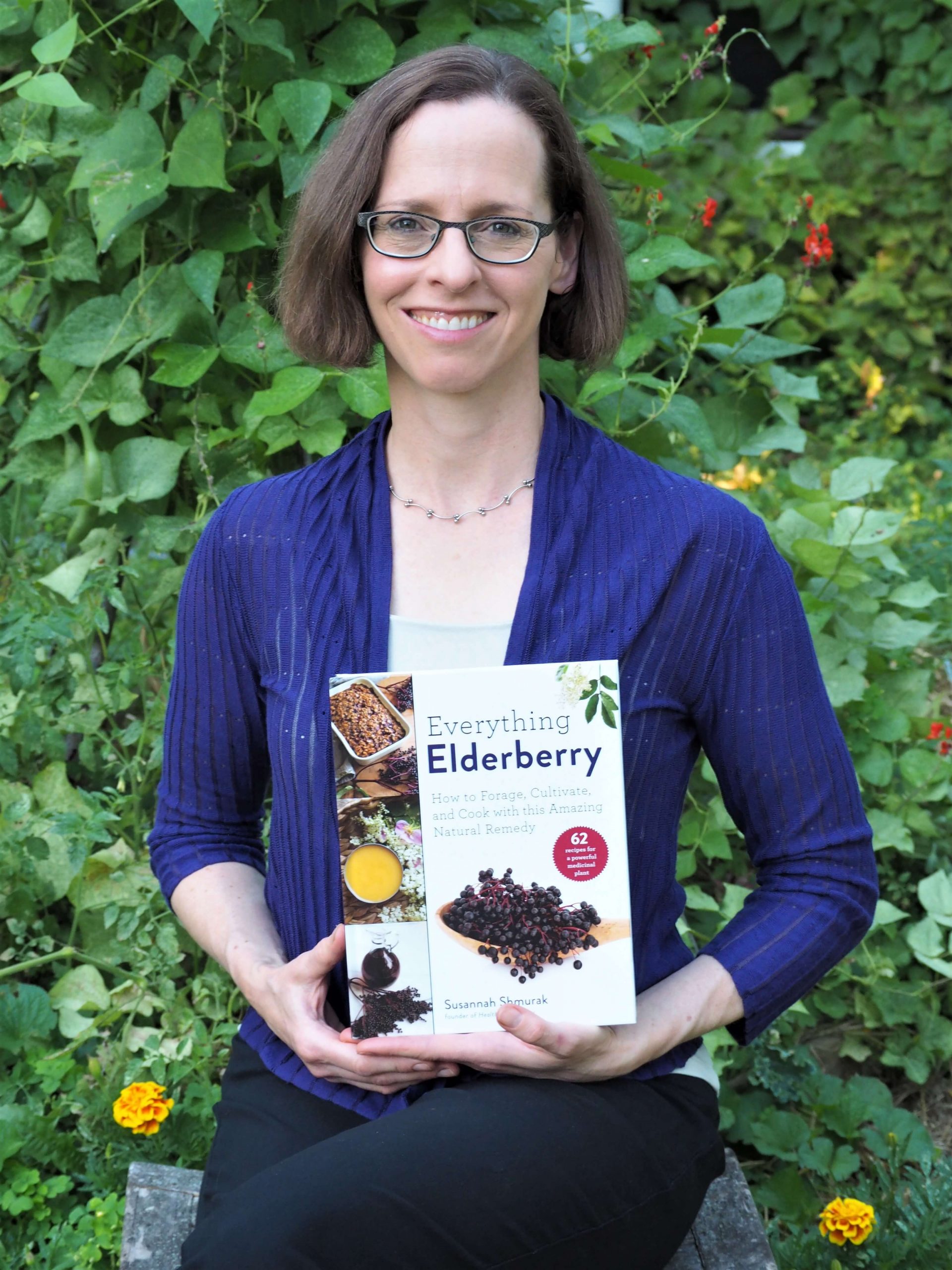Last Updated on February 14, 2025
Do you know how to grow garlic? Garlic is an easy crop that saves you money on a super-healthy food!
Growing garlic is easy, fun, and economical. Learn how to grow garlic and enjoy an endless supply of one of the world’s healthiest foods.

Each of those little cloves in your garlic bulb is actually a seed for another full head of garlic, so you can replant your garlic endlessly.
Another bonus of growing your own garlic is the delicacy of a lesser-known garden gem called spring garlic, which is the scallion-like immature plant before it begins bulbing. Spring garlic is one my favorite treats of early spring, perfect sauteed with early-maturing spinach served over pasta with parmesan cheese. Check out the easy recipe for spring garlic with asparagus and spinach over fettucine.
Better still, garlic is a great spinach companion plant, so you can harvest your ingredients for dinner from one place! It’s also among the many useful strawberry companion plants and elderberry companion plants to consider.
Why Learn How to Grow Garlic?
Besides being a flavorful addition to salsas, sauces, soups, and more, garlic deserves the label “superfood” for its impressive medicinal qualities. It’s considered an effective antimicrobial and may even protect against some types of cancer. Keep garlic around to fight off colds. Read more about the health benefits of garlic and you’ll be adding it to every meal!
Many folks swear by raw garlic for stopping viral infections in their tracks, and some limited research suggests they’re on to something. (I’m not into swallowing plain raw garlic as some advise, but mixing some fresh crushed garlic into chicken soup has perhaps helped me fight colds. I also consume a lot of elderberry tea when I feel a cold coming on. That and a good night’s sleep — thanks lemon balm tea! — and I generally find the cold never gets a chance to take hold.)
Garlic is one of the easier crops to grow as well. Plant it in the fall, mulch well, and it needs very little attention until you harvest it in summer.
Each fall I choose about 6 of my biggest cloves to grow new bulbs, and space them about 6″ apart. You might want to grow more; I get a lot of garlic as part of my CSA, so I don’t need to grow much for bulb garlic. But there’s never enough spring garlic!
Then I plant at least a dozen–sometimes two dozen–of my smaller cloves for spring garlic closer together (2-3″). When they’re ready, they look like large scallions, and you pull them up whole, using mainly the white part.
When and How to Plant Garlic
Fall is the preferred time to plant garlic, allowing the bulbs to put down roots before winter. Spring planting is possible, but less reliable, and typically yields smaller bulbs. But if you’re reading this in spring, go ahead and pop a few cloves in the ground following the directions below and see what happens. You could also harvest them as immature spring garlics.
My CSA farmers, who taught me about planting garlic and grow some of the most gorgeous and flavorful garlic I’ve ever seen, shoot for Halloween so no bulbs try to send up shoots before our loooong winter. I’ve read we amateurs might do better planting a bit earlier, but not so early that our garlic gets confused and starts sending up shoots before the frost.
You can also grow garlic as a perennial herb by leaving some of your bulbs in the ground to reproduce. Perennial vegetables produce year after year with little work required by you. Something to consider as you’re making plans for growing garlic!

How to Grow Garlic
Growing garlic is easy and fun!
Instructions
- In fall, get your seed garlic from a local farmer or online (some nurseries may also carry it). Garlic from the grocery store might be treated with chemicals, and it might not be the right variety for your region. (In the northern parts of the country we grow "hardneck" garlic, known for its large, flavorful cloves and tasty scapes. Warmer climates can grow the milder "softneck" varieties. I recommend buying direct from a local farmer so you know it's suited to your climate and you can talk to them about the timing they recommend in your area.
- Carefully separate cloves a day before planting, keeping the papery covering on each clove. Garlic can bruise, so you want to handle it gently.
- Choose a sunny location if possible, though you can grow garlic in less than full sun conditions. Garlic likes rich soil, so mix in a good amount of compost or manure. It's best to rotate your crops every year, so don't plant garlic where you've just had other members of the onion family.
- Plant your biggest cloves for bulb garlic 6 inches apart and 2-3 inches deep, with the pointy side up. Save smaller cloves for eating or plant them as spring garlic, planting only 3 inches apart and 2-3 inches deep. Plant plenty of spring garlic, as you need *at least* 5-6 of them for each pound of pasta. And be sure to remember in spring that you're only digging out those closer-spaced ones, or you won't get much in the way of garlic bulbs. I recommend marking the spring garlic so you can distinguish the two plantings.
- Mulch well with straw and/or leaves. You can pull these back when the danger of frost passes in spring to allow the soil to warm up more quickly. Put a thinner layer of mulch around plants to suppress weeds.
- Garlic wants a good inch of water per week. Stop watering about 3 weeks before harvesting bulb garlic.
- If you’ve planted hardneck garlic, keep a lookout for a small pointy shoot called a scape sometime in early summer (those curly bits in the picture at right). You want to harvest your spring garlics before they produce scapes, or the stalks get tough. You can harvest them anytime before that as well, but the longer you wait, the bigger they'll be.
- For your bulb garlic, you need to cut off the scape so the plant can focus its energy on bulb production. Let scapes grow till they start curling, and then you can use these tasty parts of the plant as well. Scapes are a great addition to stirfries or can be used in place of regular garlic in pestos and other dishes.

When and How to Harvest Garlic
- When you see the stalk yellowing, keep a watchful eye on your plants. When the plant is about 1/2-2/3 yellowed, dig up a bulb to see how it’s doing. Dig carefully, or you can split your bulbs. If you do split one, you can still use it right away, but it won’t store.
- When the bulbs you dig are well-formed and the cloves fill their skin, they’re ready. If you leave them in too long, the bulbs will start separating. Dig them up carefully, and leave the stalks on and let them cure for a couple weeks in a well-ventilated, shady spot. It’s best to leave them dirty.
- Once the roots are dry and the wrapping is papery, you can trim off roots, leaves, and extra dirt. Leave the paper on.
Storing your homegrown garlic:
- Keep in a cool, dark place, and your bulbs should be good for months. You can also try fermenting some. See these instructions from Seeking Joyful Simplicity for making easy fermented garlic.
- Don’t forget to save your largest bulbs for replanting!
Related: 40+ Vegetables that Grow in Shade
Bonus tip: In late winter, when the garlic in your pantry is getting sprouty, plant it in a container inside your house for tasty garlic scallions! Here’s how to grow vegetables indoors any time of year.
Or if you’ve never grown anything before and aren’t sure where to begin, check out my FREE quick-start guide for newbie gardeners, Get Growing! and you’ll be enjoying your own home-grown food in no time.
Have you ever tried growing your own garlic? Now that you know how to grow garlic, think you might try it this season?
Need more garden inspiration? Check out some of my favorite crops:
- How to Grow Spinach
- How to Grow Melons in Cool Climates
- How to Grow Spaghetti Squash
- Edible Landscaping 101: Growing Fruit
- 9 Ways to Grow Food in a Small Garden
- How to Grow Rhubarb
Pin to save this info on how to grow garlic for later!
Photo Credits: couleur, Isabel Eyre, Kasey Eriksen

Susannah is a proud garden geek and energy nerd who loves healthy food and natural remedies. Her work has appeared in Mother Earth Living, Ensia, Northern Gardener, Sierra, and on numerous websites. Her first book, Everything Elderberry, released in September 2020 and has been a #1 new release in holistic medicine, naturopathy, herb gardening, and other categories. Find out more and grab your copy here.


 Hi, I'm Susannah, a garden geek, energy nerd, and fan of healthy food and natural remedies. Need some simple, practical solutions for living healthier and greener? You've come to the right place! More about me and my green projects
Hi, I'm Susannah, a garden geek, energy nerd, and fan of healthy food and natural remedies. Need some simple, practical solutions for living healthier and greener? You've come to the right place! More about me and my green projects